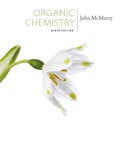
Interpretation:
Mechanisms for the three steps involved in the trapping of β- lactamase by tazobactum such as a) the reaction of the hydroxyl group on the β- lactamase to open the β- lactum ring of tazobactum b) The opening of the sulfur-containing ring in tazobactum to give an acyclic imine intermediate c) Cyclization of the imine intermediate to yield trapped β- lactamase product are to be proposed.
Concept introduction:
Three steps are involved in the conversion required. i ) Nucleophilic attack of β- lactamase on tazobactum to open the β- lactum ring ii) Formation of an imine intermediate by opening of the sulfur-containing ring in tazobactum iii) Cyclization to yield the trapped β- lactamase. All the three reactions involve the attack of nucleophiles.
To propose:
Mechanisms for the three steps involved in the trapping of β- lactamase by tazobactum such as a) the reaction of the hydroxyl group on the β- lactamase to open the β- lactum ring of tazobactum b) The opening of the sulfur-containing ring in tazobactum to give an acyclic imine intermediate c) Cyclization of the imine intermediate to yield trapped β- lactamase product.
Want to see the full answer?
Check out a sample textbook solution
Chapter 21 Solutions
EBK ORGANIC CHEMISTRY
- What would be the reagents and conditions above and below the arrow that will complete the proposed acetoacetic ester synthesis? If it cannot be done efficiently, then I will choose that answer. There could be 2 or 4 reagents involved. Please provide a detailed explanation and drawings showing how it would proceed with the correct reagents.arrow_forwardFor benzene, the ∆H° of vaporization is 30.72 kJ/mol and the ∆S° of vaporization is 86.97 J/mol・K. At 1.00 atm and 228.0 K, what is the ∆G° of vaporization for benzene, in kJ/mol?arrow_forwardThe reaction Q(g) + R(g) → Z(l) is shown to be exothermic. Which of the following is true concerning the reaction. it is spontaneous only at High T, it is spontaneous at low T it is nonspontaneous at all T it is spontanrous at all T. it is non spontaneous only at low T.arrow_forward
- The reaction Q(g) + R(g) → Z(l) is shown to be exothermic. Which of the following is true concerning the reactionarrow_forwardWhich of the following has the largest standard molar entropy, S° (298.15 K) He H2 NaCl KBr Hgarrow_forwardWhich of the following is true for a particular reaction if ∆G° is -40.0 kJ/mol at 290 K and –20.0 kJ/mol at 390 K?arrow_forward
 Organic ChemistryChemistryISBN:9781305580350Author:William H. Brown, Brent L. Iverson, Eric Anslyn, Christopher S. FootePublisher:Cengage Learning
Organic ChemistryChemistryISBN:9781305580350Author:William H. Brown, Brent L. Iverson, Eric Anslyn, Christopher S. FootePublisher:Cengage Learning Introduction to General, Organic and BiochemistryChemistryISBN:9781285869759Author:Frederick A. Bettelheim, William H. Brown, Mary K. Campbell, Shawn O. Farrell, Omar TorresPublisher:Cengage Learning
Introduction to General, Organic and BiochemistryChemistryISBN:9781285869759Author:Frederick A. Bettelheim, William H. Brown, Mary K. Campbell, Shawn O. Farrell, Omar TorresPublisher:Cengage Learning


